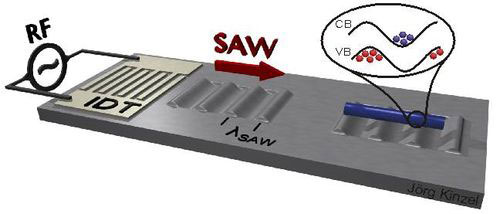| Mar 21, 2011 |
Sound makes nanowires blink
|
|
(Nanowerk News) Like copper wires in our everyday life, nanowires are envisioned to act as interconnecting elements in future electronic circuits on the nanoscale. Moreover, when made from semiconductors these nanowires not only transport electric current along their axis but also can very efficiently emit light.
|
|
In a recent publication in Nano Letters ("Directional and Dynamic Modulation of the Optical Emission of an Individual GaAs Nanowire Using Surface Acoustic Waves"), a team of NIM researchers from groups of Hubert Krenner and Achim Wixforth at University of Augsburg and Gregor Koblmüller, Gerhard Abstreiter and Jonathan Finley at the Walter Schottky Institut at TU Munich combines these two fundamental properties.
|
|
The scientists demonstrate that the light emitted from a single semiconductor nanowire can be periodically turned on and off at high speeds, faster than a nanosecond. For this purpose the physicists developed a hybrid device in which a radio frequency sound wave propagates along the nanowire and dynamically turns "on" and "off" its light emission.
|
 |
|
As a precise trigger the scientists used a surface acoustic wave, a sound wave with amplitudes of a few nanometers that propagates on the surface of the chip on which the nanowires are dispersed. They further used the unique geometry of the nanowire to deliberately enhance or suppress the switching of the light emitted by the nanowire. They found that the effect is the strongest if the sound wave travels along the axis of the nanowire while for a perpendicular alignment the emission of the nanowire was hardly affected. They explain this observation by a separation of the charges, electrons and holes, which were initially generated by a short laser pulse.
|
|
The sound wave breaks up these two types of carriers along its propagation direction and separates them in moving pockets separated by half of its wavelength. This spatial separation suppresses the emission of light and gives rise to a dynamic modulation of the detected signal. Since the wavelength of the sound wave is always much larger than the diameter of the nanowire but smaller than its length, the break up can only take place if the sound wave moves along the nanowire axis.
|
|
An interesting aspect of this acoustic technique lies in the fact that the sound wave travels along the nanowire and transports charges like on a conveyor belt. This effect could be used in future applications to transport charges for example to a quantum dot that can be formed within the nanowire by incorporating a special short section of a different material. Such quantum dots emit light as single quanta, photons, with a precise repetition rate set by the frequency of the sound wave. Such trains of single photons are crucially required for the implementation of inherently secure quantum cryptography protocols.
|

